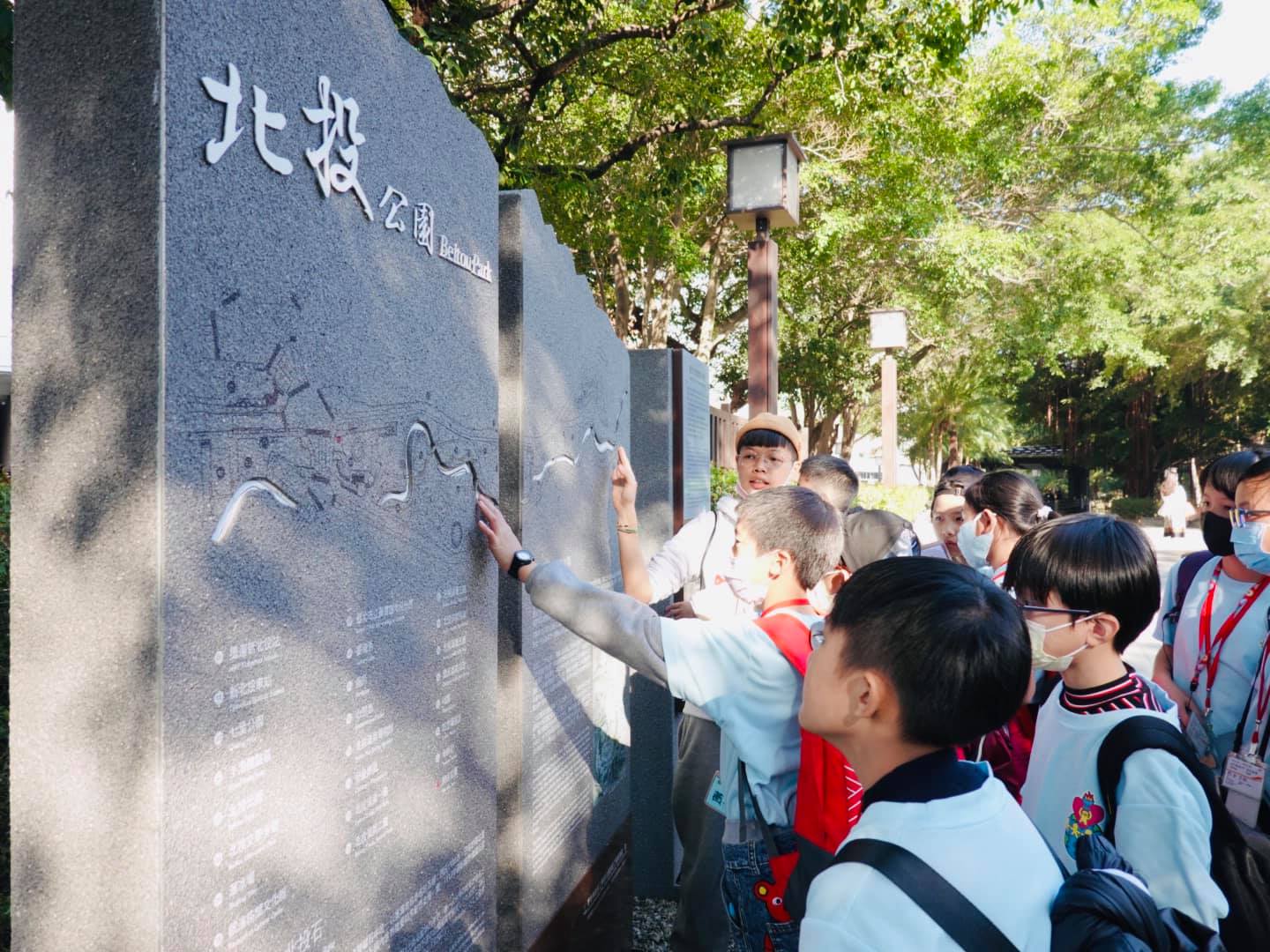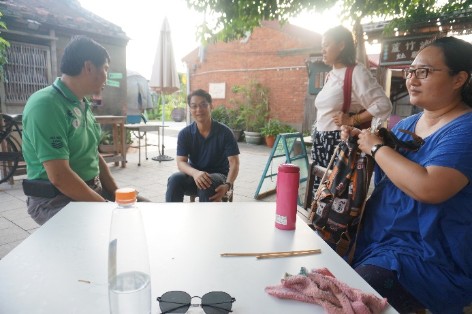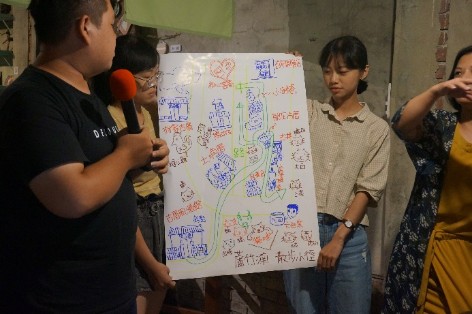計畫成果及亮點/The Achievement and Highlights of the Project
善盡社會責任:110年
{{ $t('FEZ002') }}計畫管理人|
肆、善盡社會責任
IV. Fulfilling Social Responsibility
本校成立藝術社會實踐中心,從北藝大專業領域特色出發,與在地社群形成夥伴關係,系統化建構「地方學」文化知識內涵,並著眼於創作展演轉化再現地方文化內容,從而落實藝術大學的社會責任。109至110年獲教育部核定4個案計畫。在校級協助機制上,由主冊支應專任人員1員額及基地運作業務費約197萬元,包括校內扶植「2021義家藝館:教學暨創作計畫」;依本校延攬及留住特殊優秀人才彈性薪資支給原則,以彈性薪資獎勵、全英語授課獎勵方式鼓勵參與社會實踐課程與計畫教師帶領團隊。
TNUA established “University Social Responsibility (USR) Hub”. Starting from the school's professional fields, the USR Hub fulfills social responsibility by forming partnerships within the local community, defining the cultural connotations of "local studies", and focusing on the transformation and reproduction of local cultural content through creative performance and exhibition. Between 2020-2021, the Ministry of Education approved four projects. In terms of school-level assistance mechanisms, the master plan should pay about NTD 1.97 million for one full-time staff post and site operations, including the establishment of "2021 When Home Becomes a Museum" teaching and exhibition project in the school. According to the principle of flexible salary for recruiting and retaining distinctive talents, teachers participating in social practice courses and programs are encouraged to lead the team through flexible salaries and incentives for English-language instruction.
相關連結 Related links
北藝大藝術社會實踐中心Facebook官方粉絲專頁
USR Hub of TNUA Facebook Official Fan Page
藝術社會實踐中心 深耕計畫歷年成果 USR Hub: achievements of the Sprout Project over the years
Hi-Five Plus: 從北投平埔族群到屏東原住民的國際藝術對話 Hi-Five Plus: International Art Dialogue from the Pingpu Ethnic Group in Beitou to the Indigenous People in Pingtung
藝術媒合服務學習計畫 成果 Achievements of the Arts Matching Service- Learning
1.臺北市.北投:
Taipei City. Beitou:
北投散步:歷史、環境、生活、記憶以及其展演計畫
Beitou Walking: the Interpretation and Representation of the History, Environment , Life and the Memory in Beitou.
以文化資源學院為中心,搭配舞蹈、音樂、美術、戲劇、新媒等藝術學院展演實作的創造力,透過跨域交流與整合,由三個面向切入北投,分別為「生活」子計畫:協助北投社區建構在地觀點的歷史文化內涵、多元社群、多元跨域的夥伴關係與工作模式,並鏈結臺北市政府文化局文化政策,與在地發展歷史文化內涵驅動的展演與再現型態,形塑北投地區文化公共平台;「環境」子計畫:與關渡自然公園、多寶藝術學堂合作針對關渡地區人文自然環境等議題進行探討,並以圖像提出教學或其他方案呈現作品;「街區」子計畫:與中央研究院、成功大學等師資教授GIS地圖資訊系統,再由學生進行北投地區調查研究,整理區域性地圖,結合文獻資料、口述歷史、現存遺跡等資料,進行整合與詮釋再現,建構再現已經消失的關渡老街以及其生活面貌。
藝術社會實踐中心串連校內各系所學生發揮藝術才能,加深社區發展的廣度,呼應臺北市政府文化局近年來的發展「城市觀光」、「文化永續」等文化政策,藉此協助「北投生活環境博物園區」的整合與強化文化內涵的深度,提供北投建構新的生活模式。如「北投散步—新北投公園」,由臺北藝術大學博物館研究所黃貞燕老師及團隊,針對小學生設計有趣的走讀文本、活潑的互動遊戲,帶領南郭國小五年級資優班的學生回到百年前的北投公園,利用歷史環境學的觀察進行一場時空旅行。聽公園爺爺說故事,認識公園對於當時的人們的意義,進而描繪出在日治時期時,溫泉、浴場與北投公園交織而成的「公園想像」,公園內設施的背後故事,以及公園內豐富的生態資源探索(圖10)。
Based from the School of Culture Resources, this project integrates dance, music, fine arts, drama, new media, and other creative modes within the art college. Through interdisciplinary communication and integration, it consists of three "sub-projects" which examine Beitou from three aspects. The "life" sub-project aims to help the Beitou community to construct its historical and cultural context, diverse community, diverse cross-regional partnerships, and working modes from a local perspective. It also links the cultural policies of the Taipei Municipal Government's Department of Cultural Affairs with the development, performance, and reproduction of historical and cultural content, so as to form a cultural public platform for the Beitou area. The "Environment" sub-project cooperates with Guandu Nature Park and D.B. Art Collective to discuss issues such as the human and natural environment in the Guandu area, and present their teaching patterns through image, or present their works with other methods. The "Block" Sub-Project collaborates with teachers from Academia Sinica and Cheng Kung University. Students are taught to use a GIS mapping information system and go out to research the Beitou area, analyze regional maps. They then integrate, interpret and reproduce their data in combination with local literature, oral history, existing relics, and other materials to reconstruct the life and appearance of Guandu old street.
USR Hub of TNUA connects students from all departments in the school to give full play to their artistic talents, expand community development, and echo the Taipei Municipal Government Department of Cultural Affairs' recent cultural policies, such as "urban tourism" and "cultural sustainability". This project ultimately aims to assist in the integration of the "Beitou Living Eco-Museum" and enhance cultural content to facilitate the establishment of a new lifestyle and philosophy. One example is "Beitou Walking - Beitou Park", designed by TNUA Graduate Institute of Museum Studies instructor Huang Zhan-Yan and her team. This project included designing interesting reading materials and lively interactive games for primary school students and leading the fifth grade students from Nanguo Elementary School to imagine Beitou Park a hundred years ago, using observation, history, and environmental science to travel back in time. Students were led to listen to seniors' stories, understand what the park meant to people at that time, and then describe the park in their imagination, incorporating elements such as hot springs, the Japanese colonial period, the story behind the facilities in the park, and the exploration of the park's ecological resources (Fig. 10).

圖10 南郭國小學生認識新北投公園地景圖
Fig. 10 Students from Nanguo Elementary School studying the landscape of Xinbeitou Park
2.苗栗縣.頭份.蘆竹湳:
Miaoli County. Toufen. Luzhunan
家在蘆竹湳—蘆竹湳社區保存發展陪伴計畫
Home in Luzhunan - Luzhunan Community Preservation and Development Companion Program
北藝大長期推動藝術深耕地方,用「藝術」解決在地問題。以學生學習角度出發,學院專業的藝術研究專長、文化知識的系統性爬梳能力,結合教學與實務,協助地方夥伴探索自身文化。然「藝術社會實踐」並非單一藝術形式進行,而是採複合式的創作模式,且需長期陪伴場域夥伴,擾動地方、累積藝術的能量。本計畫之場域實踐將側重於「參與式藝術」的創作實踐,使學生必須「真實地」和在地社群互動、進行共同創作。由教師開設跨域課程、移地教學等進入場域,帶領學生進行議題式學習與討論,讓學生以不同領域視角與生活週遭人事物碰撞、對話、交流,培養學生創新融合能力。
TNUA has long promoted art to deepen local cultivation and use "art" to solve local problems. From the perspective of students' learning, the college's professional artistic research expertise and systematic climbing ability of cultural knowledge, combined with teaching and practice, assist local partners to explore their own culture. However, "art society practice" is not a single art form, but a compound creation mode, and needs to accompany field partners for a long time, disturb the place and accumulate the energy of art. The field practice of this project will focus on the creative practice of "participatory art", so that students must "truly" interact with the local community and create together. Teachers will set up interdisciplinary courses and transfer teaching to enter the field to lead students to study and discuss topics, so that students can collide, talk and communicate with people and things around their lives from different field perspectives, and cultivate students' innovative and integrated ability.
「蘆竹湳社區保存發展陪伴計畫」以課程與實踐方式,參與和陪伴社區保存與發展,包括:協助「好采頭藝術季」規畫執行、以蘆竹湳為教室設計課程、辦理社區紀錄片影展。透過USR計畫,讓學生參與社區實踐、了解藝術與地方創生及社區營造結合的理論與策展方法,並協助社區連結外部資源、累積社區紀錄影像資料、協助社區專業策展、陪伴社區營造及地方創生推進(圖11、圖12)。
The Luzhunan Community Preservation and Development Companion Program participates in the preservation and development of the community through education and outreach, including: assisting in the planning and implementation of the Lu Zhu Nan Arts Festival, designing courses with Luzhunan as the “classroom”, and hosting community documentary film festivals. Through the program of USR Hub, students get involved in community outreach and learn theories and exhibition planning methods for integrating art with regional revitalization and community building. They also help the community to access external resources, accumulating community records and image materials, providing professional exhibition planning assistance, and working closely with the community through the development and promotion of regional revitalization (Fig. 11, Fig. 12).


圖11 師生與苗栗縣傳統聚落文化協會理事長合影 圖12 學生策劃主題、繪製蘆竹湳社區地圖
Fig. 11: Teachers and students take a group photo with the chairman of the Miaoli County Traditional Settlement Culture Association. Fig. 12: Students plan the theme and draw a map of Luzhunan Community
3.臺東縣.綠島.國家人權博物館:
Taitung County. Green Island. National Museum of Human Rights:
2021綠島人權藝術季「假如綠島是一面鏡子」
2021 Green Island Human Rights Art Festival "Through the Reflection of Green Island"
經過一個學期的課程與學習,學生透過對於記憶政治的文本閱讀與不同學院老師對於藝術形式參與社會議題的經驗分享,逐步構思自身所關切的議題。在臺灣過去民主轉型時代與現今社會關係中找到一個切入點,並透過藝術媒介轉化成創作,與國家人權博物館合作,開設議題式跨學院創新課程,搭配跨域實驗藝術創作提案。希望透過田野踏查與文化展演的穿透力,讓多元紛雜且曾被排除的歷史創傷記憶,在特定場址中以具有當代性的方式再現,促使綠島人權藝術季超越紀念追思的調性,轉型成能夠引領話題、提升議題關注度、推進轉型正義的藝術節慶,引起思辨、促成社會溝通對話。
Over a semester of coursework and studying, through readings on memory politics and seminars on art-based social engagement by teachers from different colleges, students gradually develop their own perspectives and ideas about various social issues. This project explores the relationship between Taiwan's contemporary society and its historical journey to democracy and transforms it into artistic creation via different artistic media. As a collaboration with the National Museum of Human Rights, this project offers issue-based intercollegiate innovation courses coupled with interdisciplinary experimental art proposals. This project hopes to use the penetrating power of field research and cultural performance and exhibition to reproduce, in a contemporary and site-specific way, the diverse and complex historical traumatic memories that have been excluded from public discourse. This project also hopes to elevate Green Island Human Rights Art Festival beyond a simple commemoration and transform it into an art festival that can lead the conversation, raise awareness about this topic, and promote transformation and justice, provoking reflection and promoting social discussion.
110年延續往年與國家人權博物館的合作,今年北藝大再度參與綠島人權藝術季,經過一學期課程指導,選出3組優秀作品參展,以錄像、詩作、新媒體裝置等多元形式映照本屆主題「假如綠島是一面鏡子」,為期3個月的展覽於綠島人權文化園區呈現。另外也首度與綠島國中合作,以兩組教育推廣工作坊將人權議題結合藝術並帶入課堂實踐。一步步引導學生隨著教案回到1950年代的綠島,反思臺灣社會該如何面對/記憶這段歷史,並進而連結到當代之民主課題(圖13)。
In 2021, the school continued its longstanding collaboration with the National Museum of Human Rights. This year, TNUA once again participated in the Green Island Human Rights Art Festival. After one semester of coursework and guidance, three groups of outstanding works were selected to participate in the exhibition. This year's theme is reflected in multimedia forms such as film, poetry, and new media installations. The "Through the Reflection of Green Island" exhibition will be displayed for three months in the Green Island Human Rights Culture Park. In addition, for the first time, we also cooperated with Green Island Junior High School to combine human rights issues with art and bring them into the classroom through two sets of educational promotion workshops. These courses guide students step-by-step back to Green Island as it was in the 1950s, invite them to reflect on how Taiwan should face/remember this history, and then help them connect this history to contemporary democratic issues (Fig. 13).
圖13 綠島國中學生於課堂上將文字轉化為視覺創作
Fig. 13 Students from Green Island Junior High transform words into visual art during a workshop
相關連結 Related Links
2021綠島人權藝術季-《假如綠島是一面鏡子》官方網站、Facebook粉絲專頁 2021 Green Island Human Rights Art Festival - "Through the Reflection of Green Island" official website, Facebook fan page
媒體露出 Media Exposure
「假如綠島是一面鏡子」 綠島人權藝術季17日開幕(陳宛茜,2021年5月16日發佈聯合新聞網)"Through the Reflection of Green Island" Green Island Human Rights Art Festival Opens on 17th (Chen Wan-Chien, published May 16, 2021 United Daily News)
假如綠島是一面鏡子:「2021綠島人權藝術季」舉鏡自照的生命層疊與歷史書寫B面(童詠瑋,2021年9月15日發佈於ARTouch)Through the Reflection of Green Island: “2021 Green Island Art Festival”, Holding Up a Mirror to Reflect Overlapping Lives and the B-side of Historiography (Tung Yung-Wei, published on ARTouch on September 15, 2021)
{{ $t('FEZ003') }}2022-01-12
{{ $t('FEZ004') }}2025-05-11|
{{ $t('FEZ005') }}423|
